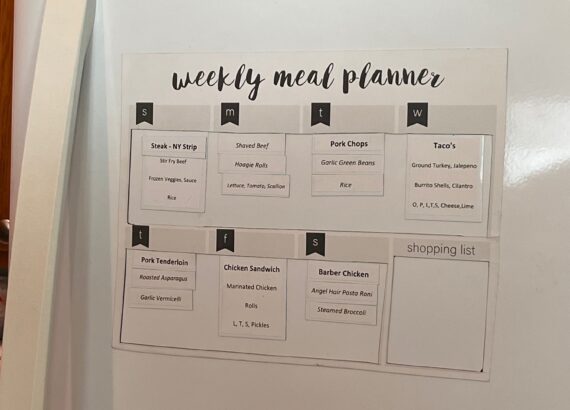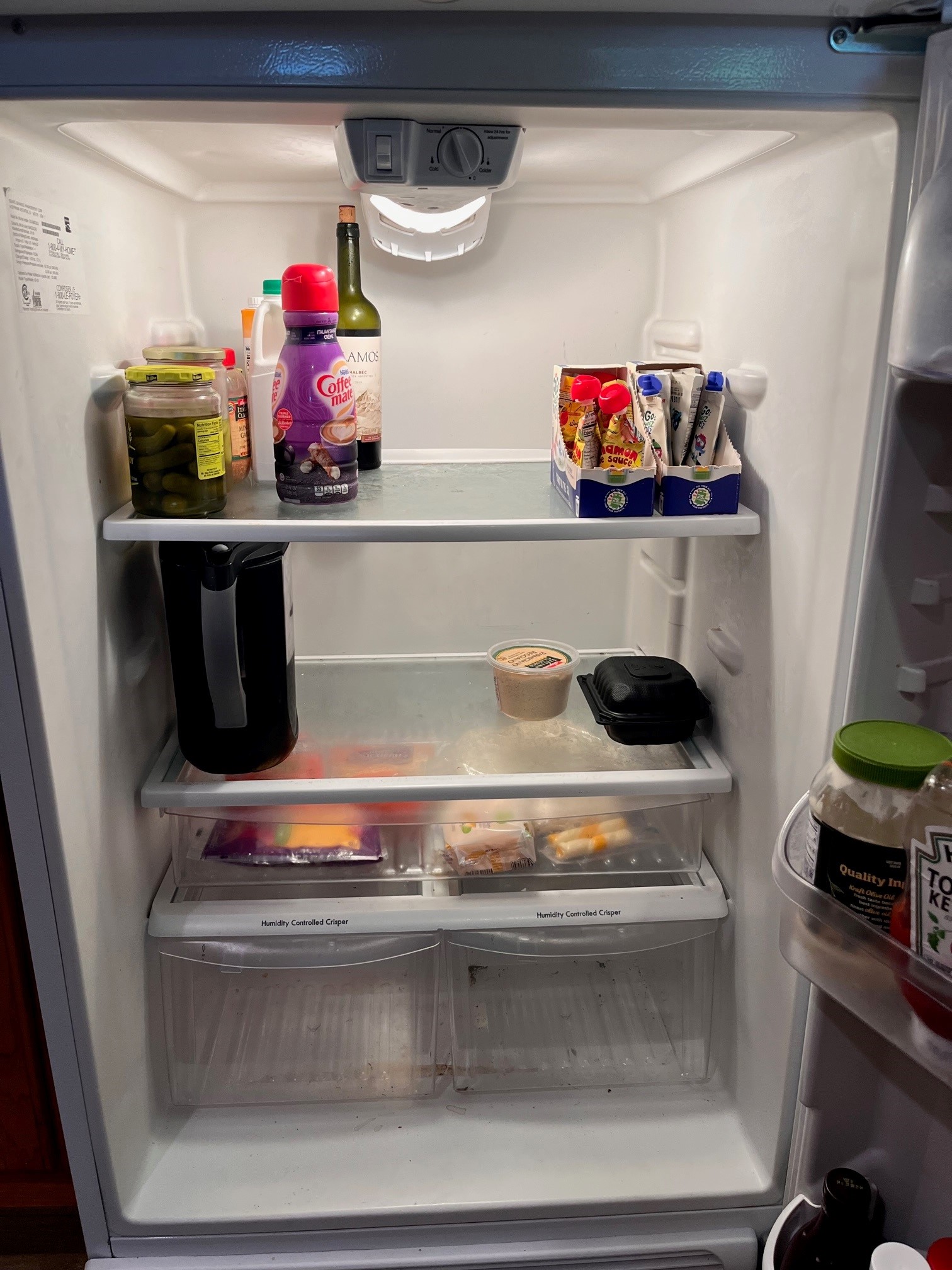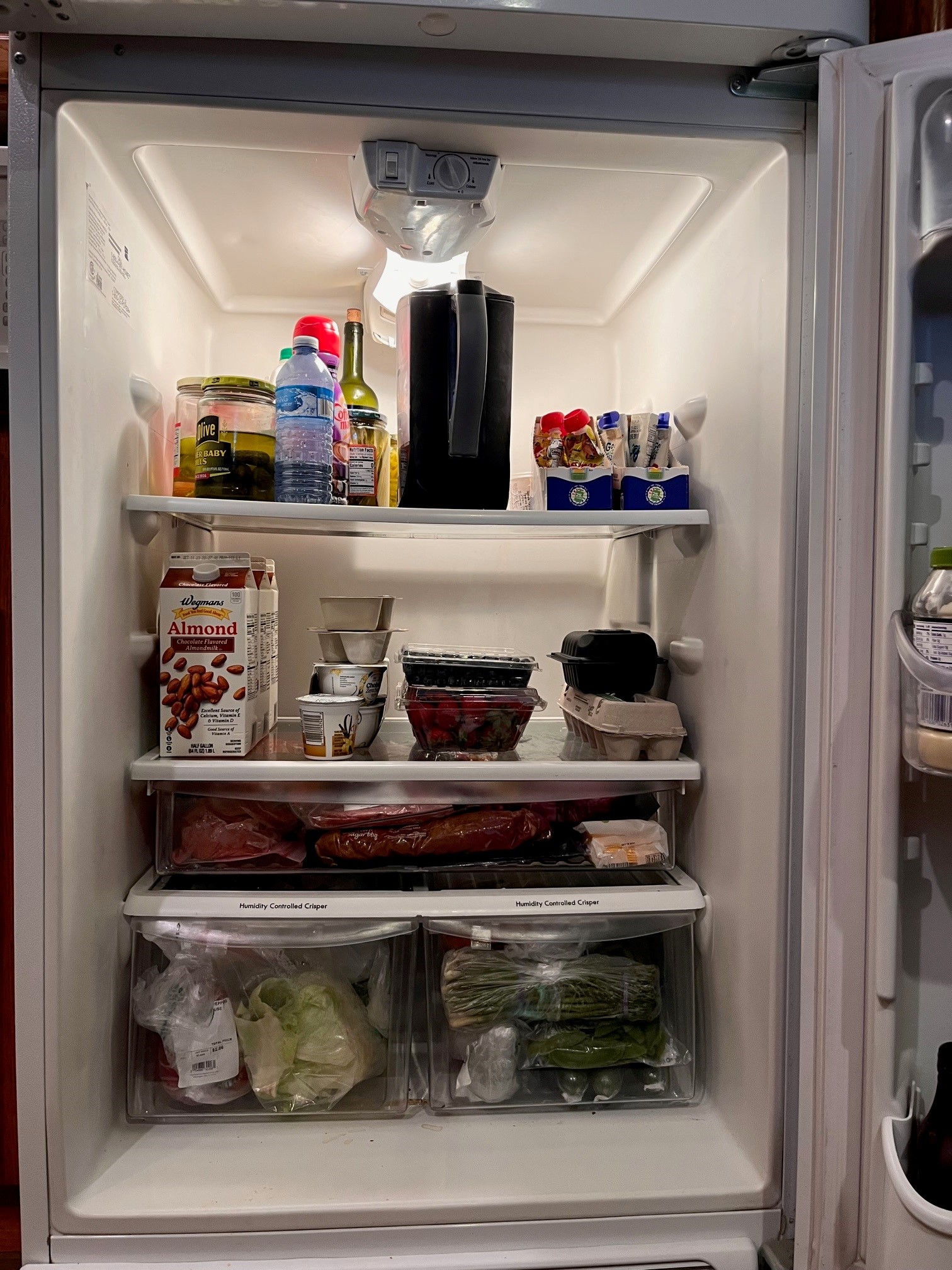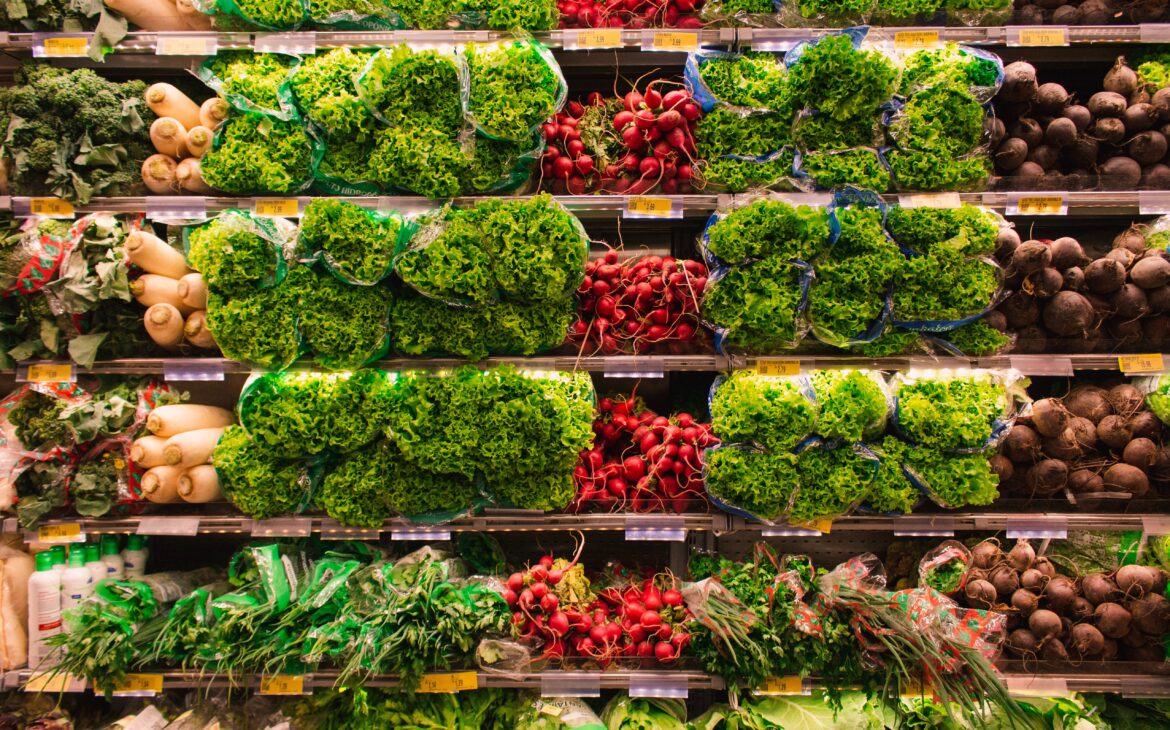In today’s fast-paced world, planning your weekly grocery shopping might seem like a mundane task. However, for those who are dedicated to managing their household budget and reducing food waste, this routine can be a game-changer. I’ve found that a well-thought-out grocery shopping plan not only keeps my kitchen perfectly stocked but also helps me save money and reduce food waste. In this blog post, I will take you through my systematic approach to weekly grocery shopping, from cleaning out the refrigerator to creating a detailed shopping list. **As an Amazon Associate, I earn from qualifying purchases.**(Any word(s) that are bold and turn green when you hover over them are product links.)
A Savvy Approach to Savings and Minimal Waste
Embarking on a weekly grocery shopping trip may sound like just another chore on your to-do list, but for those who view it as a strategic mission, it can become a gateway to both culinary delight and financial wisdom. Picture this: a pantry and freezer carefully curated, a refrigerator that’s nearly bare by week’s end, and a wallet that stays pleasantly plump. It’s not a magic trick; it’s the art of planning. In this blog post, we’ll delve into the intricacies of my weekly grocery shopping ritual. By starting with a clean slate, crafting a well-balanced menu, considering breakfasts and lunches, accounting for household necessities, and employing modern technology to streamline the process, you’ll not only make the most of your shopping experience but also master the art of mindful consumption.
So, let’s embark on this journey towards efficient grocery shopping, where every purchase serves a purpose and where both your kitchen and your finances are in harmony. Let’s dive in and discover how you can efficiently plan your weekly grocery shopping.
Go Through Your Refrigerator: The First Step to Efficient Grocery Shopping
Before I even think about heading to the grocery store, I start by going through my refrigerator. This is a crucial step because it ensures that I’m not just piling new groceries on top of old ones, which can lead to food spoilage and waste. Here’s what I do:
- Clean out any old leftovers: I begin by removing any lingering leftovers or items that have passed their prime. This not only frees up space but also prevents any unpleasant surprises later.
- Check expiration dates: It’s important to check the expiration dates on items like dairy products, condiments, and sauces. This helps me identify what needs to be used up quickly.
- Inspect leftover fruits and vegetables: I take a close look at the state of any leftover fruits and vegetables. If they’re still in good condition, I try to incorporate them into my meal plan for the week.
- Review the pantry: Besides the refrigerator, I also take a peek into my pantry. This quick inspection helps me identify any canned goods, grains, or other non-perishables that I should consider using in my upcoming meals.
- Assess the freezer: The freezer can be a treasure trove of forgotten ingredients. I check what’s stored in my freezer and look for items that should be used soon to prevent freezer burn or loss of flavor. This step not only helps reduce food waste but also sparks creativity in meal planning based on what’s available.
This comprehensive assessment of the refrigerator, pantry, and freezer ensures that I make the most of what I already have on hand before venturing out to purchase new items.
Make a Dinner Menu for the Week
Crafting a dinner menu for the week is a strategic move that not only ensures that you have well-balanced meals but also helps you make the most of what’s already in your kitchen. Here’s how I do it:
- Incorporate family favorites: While planning the menu, I consider the preferences of my family members. I include dishes that are their favorites, making mealtime more enjoyable and reducing the chances of uneaten leftovers.
- Optimize ingredient usage: Beyond leftovers, I also take stock of any ingredients in my pantry or freezer that need to be used up. This proactive approach helps minimize food waste and ensures that I’m not overlooking any hidden gems in my kitchen.
- Plan for variety: I aim to incorporate a diverse range of ingredients and cooking methods throughout the week. This keeps meals interesting and ensures that I’m making the most of the ingredients I have on hand.
- Consider dietary needs: If there are dietary restrictions or special preferences within the family, I factor these in while planning the menu. This way, everyone can enjoy delicious and satisfying meals.
- By keeping these additional points in mind while creating my dinner menu, I not only reduce food waste but also ensure that my family’s culinary desires are met.
Helpful Tip:
I have a magnetic weekly meal planner on my refrigerator that I made, with specific food magnets that I can insert under the day of the week to make up meals. Our family primarily likes to eat some type of protein, 1 or two vegetables, and then a starch or bread item. (See picture of this week’s menu.)
There is tutorial on how to make this Magnetic Weekly Meal Planner with interactive dinner and food magnets. Head on over to the resources page HERE. There 4 downloadable and printable items: How to…Instructions, the Weekly Meal Planner and two pages of dinner and food items. (Items need for this project: 8-1/2 x 11 Adhesive Magnetic Sheets, Downloaded and Printed Planner pages, Cutting Mat and Cutting Tools (Scissors, X-Acto Precision Knife and/or Craft Paper Trimmer)

There are also two downloadable and printable weekly meal planners and grocery lists, on the resources page, if you need a weekly planner or grocery list to write on.
Decide What’s Needed for Breakfasts and Lunches
Planning isn’t limited to dinner alone. I also consider what’s needed for breakfasts and lunches. This not only saves time but also ensures that we have our favorite items readily available. Here’s how I tackle breakfast and lunch planning:
- Leverage leftovers: I determine if there will be any dinner leftovers that my fiancé and I can use for our lunches. This is an excellent way to get a two-for-one deal out of the previous night’s dinner.
- Consistent breakfast and lunch items: We each have our go-to breakfast and lunch items, which makes shopping for them relatively straightforward. This consistency simplifies our grocery list.
Helpful Tips:
- Bulk purchases for breakfast, lunch and snack staples: For items like cereal, bread, or granola bars that are staples in our breakfast and lunch routines, I often buy in bulk. This reduces the frequency of these items appearing on my shopping list, saving both time and money.
- Prep-ahead lunch options: I consider preparing some lunch options in advance, such as sandwiches or salads in reusable containers. This not only simplifies weekday mornings but also reduces the temptation to eat out, which can be costly.
Figure Out All the Other Essentials
Beyond planning for meals, there are several other household essentials that need to be accounted for during your weekly grocery shopping. These items are crucial for maintaining a smoothly running household. Here’s a more detailed look at this step:
- Paper products: This category includes items like paper towels, napkins, and tissues. I take a moment to assess our current stock and add these items to my shopping list if necessary. Buying in larger quantities or opting for eco-friendly options can be both cost-effective and environmentally responsible.
- Laundry items: Detergents, fabric softeners, and stain removers are essential for keeping our clothes clean and fresh. I make sure to check our supply and add these items to the list if running low. Sometimes, buying larger containers can be more economical in the long run.
- Cleaning products: Keeping the home clean requires various cleaning agents like surface cleaners, bathroom cleaners, and window sprays. I take note of what needs replenishing and ensure I have the necessary supplies to maintain a clean and hygienic living space.
- Toiletries: Personal hygiene products like toothpaste, soap, shampoo, and conditioner are everyday essentials. I make sure to have an adequate supply of these items to avoid last-minute runs to the store.
- Pet supplies: If you have pets, planning for their needs is essential. This includes pet food, treats, and any grooming or hygiene products. Buying pet supplies in larger quantities, especially if your pets have consistent preferences, can be a budget-friendly approach.
- Miscellaneous items: Depending on your household’s specific needs, there might be additional items to consider, such as light bulbs, batteries, or specific tools. Keeping a small inventory of these items and restocking them when necessary ensures that you’re always prepared for any household situation.
By addressing these household essentials during your weekly grocery shopping planning, you not only maintain a perfectly stocked and functional home but also prevent last-minute dashes to the store for urgently needed items. This strategic approach to shopping extends the benefits of efficient planning beyond just groceries.
The List: Transforming Planning into Action
Now that you’ve taken stock of your kitchen, planned your meals, and considered all household essentials, it’s time to transform your careful planning into a concrete shopping list. This step is where the rubber meets the road and where you’ll ensure that your shopping trip is as efficient and cost-effective as possible. Here’s a deeper dive into creating a well-structured shopping list:
- Selecting the right format: While some people prefer a traditional pen-and-paper list, I’ve found using my favorite grocery store’s app to be incredibly practical. Whether you choose a physical list or a digital one, the key is to create an organized structure.
- Cataloging grocery items: As you go through your meal plan, pantry, and household essentials, start adding items to your list. Be specific about quantities and sizes, which will help you avoid overbuying or forgetting crucial items.
- Utilize technology: If you opt for a grocery store app like I do, take advantage of the features it offers. Search for products, add them to your virtual shopping list, and make use of the per-unit price information, product images, and aisle locations to streamline your shopping.
- Budget-conscious shopping: Keep a close eye on your budget as you create your list. Many grocery store apps provide an estimated total, which can help you stay on track. If you find that your list exceeds your budget, consider making adjustments by prioritizing essential items and removing any non-essential indulgences.
- Organized by store layout: One of the benefits of using a grocery store app is that your list is often sorted in the same order as the store layout. This means you won’t waste time crisscrossing the store in search of items. If you’re using a physical list, you can create your own categories based on your store’s layout to save time.
- Special considerations: If you have specific dietary requirements or allergies, make sure to clearly note these on your list to avoid any accidental purchases. Additionally, consider any coupons or discounts that may be available for items on your list to maximize savings.
- Double-check your list: Before heading to the store, take a moment to review your list. Ensure that you haven’t missed any crucial items and that your quantities align with your needs. This final check can save you from having to make multiple trips or picking up forgotten items during the week.
By following these steps, you can create a comprehensive and organized shopping list that not only helps you efficiently navigate the store but also keeps you within your budget. A well-structured list transforms your planning into action, making your shopping trip smooth and successful.
***There are two downloadable and printable lined grocery lists on the resources page. Either click HERE, or there is also a link at the bottom of this blog.
The Extras: Adding a Dash of Delight
With the main shopping list in hand, it’s time to consider the “extras.” These are the items that go beyond the essentials, adding a bit of variety and indulgence to your weekly groceries. Here’s how I approach this step:
- Budget evaluation: Before diving into the extras, I revisit my budget to see if there’s any wiggle room. While sticking to a budget is crucial, it’s also important to acknowledge that a little flexibility can go a long way in keeping your family satisfied and content throughout the week.
- Snacks for all: I like to add a few snack options to my list. This keeps everyone in the family happy and reduces the temptation to make spontaneous, more expensive snack purchases later in the week. Whether it’s chips, cookies, or a healthy alternative like nuts and dried fruit, these snacks can add a delightful touch to daily routines.
- Dessert options: A sweet treat at the end of a meal can be a comforting ritual. I consider adding dessert options like ice cream, fruit, or a bakery item to my list. This doesn’t just satisfy our cravings but also helps us avoid last-minute dessert runs to the store.
- Recipe experimentation: If I come across a new recipe I want to try during the week, I make sure to add the necessary ingredients to my list. This keeps mealtime exciting and encourages culinary exploration.
- Special occasions: If there’s a special occasion or celebration coming up during the week, like a birthday or anniversary, I account for any special ingredients or items required for the celebration.
Remember, the extras are about striking a balance between sticking to your budget and adding elements of joy and variety to your week. By planning for these extras in advance, you can maintain control over your spending while ensuring that your family’s cravings and desires are well-catered to throughout the week.
The Actual Shopping: Turning Plans into Purchases
I’ll admit it – I’m not a fan of shopping, be it for clothes or groceries. However, using the grocery store app has made the experience far more efficient and less painful. While the planning process is crucial, the actual shopping trip is where your strategy comes to life. With my organized list, I can breeze through the store, pick up what I need, and get out quickly.
Here’s a more detailed look at how I approach this step:
- Shopping day selection: Choosing the right day to shop is essential. I prefer Sundays for my grocery trips as it allows me to start the week with a well-stocked kitchen. However, your choice may depend on factors like your work schedule and store hours. Aim for a time when the store is less crowded to maximize efficiency.
- Reusable bags and shopping cart: I always bring my reusable bags, not only for environmental reasons but also because it’s more convenient. If you have a large shopping list, consider using a shopping cart or basket to ensure you can comfortably carry everything.
- Stick to the list: The key to successful shopping is discipline. Stick to your list as closely as possible, and avoid impulsive purchases. While it’s tempting to grab items not on your list, these unplanned purchases can quickly add up and disrupt your budget.
- Check for discounts and deals: As you shop, be on the lookout for any discounts or deals. Many stores have sales and promotions that aren’t always reflected on your list. Consider substituting brand names with store brands or generics if they offer a cost-saving without compromising quality.
- Freshness and quality: When selecting fresh produce, meats, and dairy, be attentive to quality. Check expiration dates and inspect items for any signs of spoilage or damage. This ensures that the food you bring home is of the highest quality.
- Adjustments on the fly: While it’s important to stick to your list, sometimes adjustments are necessary. If an item on your list isn’t available or if you spot a great deal on a staple item, be flexible enough to make the necessary changes.
- Beware of sales traps: Be cautious of marketing strategies like “buy one, get one free” offers or eye-catching displays. While these can be advantageous, they can also lead to buying more than you need. Evaluate whether the deal aligns with your meal plan and budget before adding it to your cart.
- Checkout mindfulness: As you head to the checkout counter, double-check your cart to ensure you have everything on your list. Avoid last-minute additions to your cart at this stage.By adhering to these shopping strategies, you can turn your well-thought-out plans into successful purchases. A disciplined approach helps you stay within budget, maximize your time, and ensure that your kitchen is stocked with the items you need for the week ahead.
Everything Gets Put Away in Its Place: Organized and Ready to Enjoy
After the successful completion of your grocery shopping trip, the final step is just as crucial as the planning and purchasing phases. This is where you bring all your groceries home and ensure that they are organized, stored properly, and ready for consumption. Let’s delve deeper into this step:
- Unpacking and organization: As soon as I return home, I begin by unpacking the groceries. I sort items by category—produce, dairy, meat, pantry staples, and so on. This initial organization not only makes it easier to put items away but also helps me keep track of what I have on hand.
- Storing perishables: Perishable items like dairy, meats, and fresh produce go straight into the refrigerator. It’s crucial to store these items at the right temperature to maintain freshness and safety.
- Cleaning produce and awareness of “The Dirty Dozen”: Did you know about “The Dirty Dozen”? This list, released by the Environmental Working Group (EWG), identifies the fruits and vegetables with the highest occurrences of pesticides. Items like strawberries and spinach top the list, followed by some fruits, such as stone fruits like nectarines, peaches and cherries, apples, grapes, pears, and tomatoes as well as a few vegetables like celery, potatoes, and sweet bell peppers. That’s why it’s essential to clean your produce before consumption. I have a special method for cleaning fruits like berries, grapes, apples, and peaches. (See Helpful Tip)
- Processing fruits and vegetables: For fruits and vegetables that require preparation, I take the time to wash, peel, and chop them as needed. This prep work ensures that they are ready to use during the week, making meal preparation more efficient.
- Storage containers: I use a variety of storage containers to keep my food organized. Clear containers make it easy to see what’s inside, and they also help extend the shelf life of fruits and vegetables. Additionally, I label items with their purchase or expiration dates to ensure that nothing goes to waste.
- Freezer and pantry organization: I also take a moment to organize my freezer and pantry. This helps me locate items quickly and prevents items from getting lost or forgotten.
Helpful Tip:
I soak my fruits and vegetables in a mixture of water, vinegar, and baking soda for about 15 minutes. This solution helps remove any pesticides or contaminants from the surface of the fruit, ensuring that it’s safe to eat.
By completing this final step with care and attention, you ensure that your groceries are not only stored safely but also organized for efficient use throughout the week. This step is crucial for maintaining food quality and reducing food waste, as it helps you keep track of what you have and encourages you to use items before they expire.
Here’s a side-by-side comparison of my refrigerator before I shop on Sunday morning and after I shop and put everything away.

Empty Fridge on Sunday Morning

Full Fridge on Sunday Afternoon
Let’s kick off the conclusion with a touch of humor:
“Why did the grocery list become a stand-up comedian? Because it wanted to ‘wrap up’ the shopping trip with a punchline!”
Now that we’ve had our dose of food-related fun, here are some final thoughts. Weekly grocery shopping may seem like a routine task, but it wields a remarkable potential for saving both time and money. The strategic steps involved—cleaning the refrigerator, crafting a dinner menu, considering breakfasts and lunches, noting household essentials, and using technology for an efficient shopping list—combine to streamline your shopping experience.
Furthermore, this well-organized approach is not limited to the grocery store; it extends to your entire lifestyle. It’s a pathway to minimize food waste, maximize your budget, and cultivate a more sustainable and creative relationship with food.
As you embark on your next grocery shopping adventure, keep these strategic steps in mind. They’re not just about shopping; they’re a roadmap to a more efficient, mindful, and cost-effective way of life.
Enjoy your shopping journey, and may it contribute to the symphony of your daily routines!
Click the button below for the downloadable and printable Magnetic Weekly Meal Planner with interactive dinner and food magnets, and weekly meal planners and lined grocery lists that can be written on.
Subscribe to updates and our newsletter!
Contact Us
contact@neatandcozyhouse.com
By submitting your email address, you hereby consent to receive weekly post emails and monthly newsletters from The Neat and Cozy House. We will use your email address solely for the purpose of sending you these updates, and we assure you that your information will be kept confidential.
You have the right to unsubscribe at any time by clicking the “Unsubscribe” link in the footer of our emails. Your decision to unsubscribe will take effect immediately, and you will no longer receive our weekly post emails and monthly newsletters.
We value and respect your privacy. For more information on how we handle your data, please refer to our Privacy Policy.
Thank you for subscribing!


